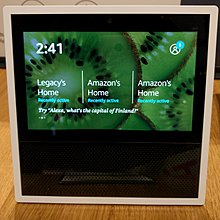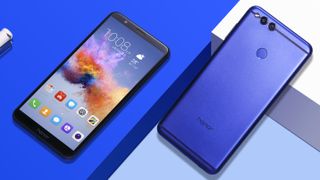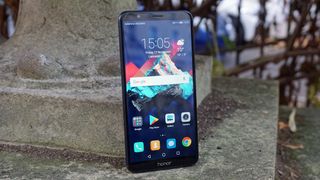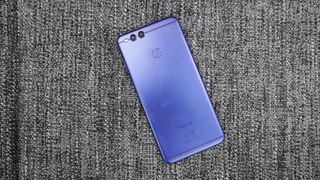BUY ONLINE EXCLUSIVELY ON Amazon. Com::>>
https://www.amazon.in/gp/product/B0725W7Q38/ref=as_li_qf_asin_il_tl?ie=UTF8&tag=9689392280-21&creative=24630&linkCode=as2&creativeASIN=B0725W7Q38&linkId=2799bc053277a3c06789efe372b11afb
BUY ECLUSIVELY ON Amazon. Com::>>
https://amzn.to/2zsVmFA
Amazon Echo
Amazon Echo (shortened and referred to as Echo) is a brand of smart speakers developed by Amazon.com. The devices connect to the voice-controlled intelligent personal assistantservice Alexa, which responds to the name "Alexa". This "wake word" can be changed by the user to "Amazon", "Echo" or "Computer".[1][2] The device is capable of voice interaction, music playback, making to-do lists, setting alarms, streaming podcasts, playing audiobooks, and providing weather, traffic and other real-time information. It can also control several smart devices acting as a home automation hub.
Amazon Echo

The first-generation Amazon Echo
DeveloperAmazon.comManufacturerAmazon.comTypeSmart speakerRelease dateNovember 6, 2014Operating systemFire OSInputVoice commandsWebsiteAmazon Echo (US)
Amazon Echo (UK)
Amazon Echo (Germany)
Amazon Echo (India)
Amazon had been developing Echo devices inside its Lab126 offices in Silicon Valley and Cambridge, Massachusetts since at least 2010 in confirmed reports. The device was part of Amazon’s first attempts to expand its device portfolio beyond the Kindle e-reader.[3]The Echo was prominently featured in Amazon's first-ever Super Bowl ad in 2016.[4]
The first-generation Echo was initially limited to Amazon Prime members or by invitation, but became widely available in the United States on June 23, 2015.[5] Press speculated that it would make its Canadian debut in mid-to-late 2016, after Amazon posted job listings for developers for Alexa and co-hosted a hackathon in Toronto.[6] The Echo became available in the United Kingdom on 28 September 2016.[7][8] Additionally, the Alexa voice service is available to be added to other devices and other companies' devices and services are encouraged to connect to it.[9]
FeaturesEdit
See also: Amazon Alexa
Overview of operationEdit
In the default mode, the device continuously listens to all speech, monitoring for the wake word to be spoken, which is primarily set up as "Alexa" (derived from Alexa Internet, the Amazon-owned Internet indexing company). Echo's microphones can be manually disabled by pressing a mute button to turn off the audio processing circuit.[3]
Echo devices require a wireless Internet connection in order to work. Echo's voice recognition capability is based on Amazon Web Services and the voice platform Amazon acquired from Yap,[10] Evi, and IVONA[11] (a Polish-based specialist in voice technologies used in the Kindle Fire).[12]
The smart speakers perform well with a 'good' (low-latency) Internet connection which minimizes processing time due to minimal communication round trips, streamable responses and geo-distributed service endpoints. While the application is free, an Amazon account is required, and setup is not possible without one.
Available servicesEdit
Echo devices offer weather from AccuWeather and news from a variety of sources, including local radio stations, iHeartRadio, BBC, NPR, and ESPN from TuneIn.[13] Echo can play music from the owner's Amazon Music accounts[14] and has built-in support for the Pandora and Spotifystreaming music services[15] and has support for IFTTT and Nest thermostats.[16] Echo can also play music from streaming services such as Apple Music, and Google Play Music from a phone or tablet. Echo maintains voice-controlled alarms, timers, shopping and to-do lists and can access Wikipedia articles. Echo will respond to your questions about items in your Google calendar. It also integrates with Yonomi,[17] Philips Hue, Belkin Wemo, SmartThings, Insteon, and Wink.[18][19]Additionally, integration with the Echo is in the works for Countertop by Orange Chef, Sonos,[20] Scout Alarm, Garageio, Toymail, MARA, and Mojio.[21] Questions like "Who is Kim Kardashian?" are answered by reading the first few lines of the corresponding Wikipedia article.[22]
It does not appear to be capable of playing music streamed from a local UPnP/DLNA media server.[citation needed]
Echo devices also have access to 'skills' built with the Alexa Skills Kit. These are third-party-developed voice experiences that add to the capabilities of any Alexa-enabled device (such as the Echo). Examples of skills include the ability to play music, answer general questions, set an alarm, order a pizza, get an Uber, and more. Skills are continuously being added to increase the capabilities available to the user. The Alexa Skills Kit is a collection of self-service APIs, tools, documentation and code samples that make it fast and easy for any developer to add skills to Alexa. Developers can also use the "Smart Home Skill API",[23] a new addition to the Alexa Skills Kit, to easily teach Alexa how to control cloud-controlled lighting and thermostat devices. All of the code runs in the cloud – nothing is on any user device. A developer can follow tutorials to learn how to quickly build voice experiences for their new and existing applications.[24]
Voice systemEdit
The devices have natural lifelike voices resulting from speech-unit technology.[25][additional citation(s) needed] High speech accuracy is achieved through sophisticated natural language processing(NLP) algorithms built into the Echo's text-to-speech (TTS) engine.[citation needed]
Software updatesEdit
As with all Alexa devices, the functionality of Echo smart speakers periodically evolves as Amazon releases new software for it. Most new releases fix bugs in addition to including enhanced functionality. New releases are pushed to the devices on a gradual basis so it may take several days to a week or more for a particular device to be updated. Because much of Echo's intelligence lies in the cloud, significant functional enhancements can be made to Echo without updating the software version it is running. For example, in April 2015, the Echo added the ability to give live sports scores without updating the software version running on the device.[26]
VariantsEdit
EchoEdit
Amazon Echo (first generation)
Amazon Echo unpacked, January 2015
Release date
November 6, 2014(Amazon Prime and invited members)June 23, 2015 (released in the U.S.)September 28, 2016(released in the U.K.)October 26, 2016(released in Germany)
Introductory priceUS$179.99
GB£149.99
EUR€179.99ConnectivityWiFi and BluetoothWebsiteAmazon Echo (US)
Amazon Echo (UK)
Amazon Echo (Germany)Amazon Echo (second generation)Release date
October 31, 2017(released in the U.S.)
Introductory priceUS$99.99ConnectivityWiFi and BluetoothWebsiteAmazon Echo (US)
Amazon Echo (UK)
Amazon Echo (Germany)
Amazon Echo (India)
Amazon Echo (Canada)
The first-generation Amazon Echo consists of a 9.25 inch (23.5 cm) tall cylinder speaker with a seven-piece microphone array.[3] The Echo hardware complement includes a Texas Instruments DM3725 ARM Cortex-A8processor, 256MB of LPDDR1 RAM and 4GB of storage space.[27] As of July 2017, the first-generation Echo maintained an 83% scoreon GearCaliber, a review aggregator.
Although the Echo is intended to be voice-controlled at the unit, a microphone-enabled remote control similar to the one bundled with the Fire TV is available for purchase. An action button on top of the unit is provided for user setup in a new location, and the mute button allows the microphones to be turned off.[28] The top half-inch of the unit rotates to increase or decrease the speaker volume. The Echo must be plugged in to operate since it has no internal battery.[29]
Echo provides dual-band Wi-Fi 802.11a/b/g/n and Bluetooth Advanced Audio Distribution Profile (A2DP) support for audio streaming and Audio/Video Remote Control Profile (AVRCP) for voice control of connected mobile devices.[30]
Limited editionsEdit
As part of a holiday promotion, Seattle Seahawks player Marshawn Lynch drove the Treasure Truck around Seattle in December 2016 selling a limited-edition beast-mode Echo with a custom skin.[31] The beast-mode version was a first-gen Echo that responded to a user's commands with Marshawn Lynch's voice, instead of the Alexa voice.[32]
In November 2017, a Product Red version of the 2nd-gen Echo was announced as a limited edition item.[33]
AvailabilityEdit
As of February 2018, the second-generation Echo is available in 36 countries.
 Austria
Austria Australia
Australia Belgium
Belgium Bolivia
Bolivia Bulgaria
Bulgaria Canada
Canada Chile
Chile Colombia
Colombia Costa Rica
Costa Rica Cyprus
Cyprus Czech Republic
Czech Republic Ecuador
Ecuador El Salvador
El Salvador Estonia
Estonia Finland
Finland Germany
Germany Greece
Greece Hungary
Hungary Iceland
Iceland India
India Japan
Japan Latvia
Latvia Liechtenstein
Liechtenstein Lithuania
Lithuania Luxembourg
Luxembourg Malta
Malta Netherlands
Netherlands New Zealand
New Zealand Panama
Panama Peru
Peru Poland
Poland Portugal
Portugal Slovakia
Slovakia Sweden
Sweden United Kingdom
United Kingdom United States
United States Uruguay
Uruguay
Echo DotEdit

The black Amazon Echo Dot (second generation) sitting idle on a wood surface
In March 2016, Amazon unveiled the original Amazon Echo Dot,[34] which is a hockey puck-sized version of the Echo designed to be connected to external speakers due to the size of the onboard speakers, or to be used in rooms such as the bedroom as an alternative to the full-sized Echo. Beyond these distinctions, the Amazon Echo Dot possesses the same functions as the original Amazon Echo.[35]
External third-party portable batteries[36] are available for the Dot.
The second generation of the Amazon Echo Dot became available on October 20, 2016. It is priced lower, has improved voice recognition, and is available in black and white. The Echo Spatial Perception (ESP) technology allows several Echo and Dot units to work together so that only one device answers the request.[citation needed] As of November 2017, the Echo Dot maintained a 78% score on GearCaliber, based on 23 reviews.[37]
Amazon TapEdit

The Amazon Tap https://amzn.to/2zsVmFA
The Amazon Tap is a smaller portable version of the Echo.[38] The Tap can do the same things as the Echo; however, as it is battery-powered, it is also portable.[39] Initially the user had to press an activation button on the front of the Tap to speak commands. However, a February 2017 software update allows the option of activating the Tap with an activation word, just like the Echo and the Dot.[40]
Echo LookEdit https://amzn.to/2zsVmFA
In April 2017, the Amazon Echo Look was introduced as a camera with Alexa built-in, for US$20 more than the first-generation Echo.[41https://amzn.to/2zsVmFAThe device can provide artificial intelligence outfit recommendations, take photos, and record videos; in addition to the features available on the Echo.[42]https://amzn.to/2zsVmFA offers Amazon Alexa's key feature plus a camera to take full-length photos and 360-degree videos with built-in AI for fashion advice.[43]https://amzn.to/2zsVmFA 44https://amzn.to/2zsVmFA As a consumer product, it helps catalog your outfits and rates your look based on “machine learning algorithms with advice from fashion specialists.[45]https://amzn.to/2zsVmFA
As of April 2017, the device is available for purchase by invitation-only in the U.S.[46]
Echo Show https://amzn.to/2zsVmFA
Main article: Amazon Echo Show https://amzn.to/2zsVmFA

The Amazon Echo Show
In May 2017, Amazon introduced the Echo Show, which features a tactile 7-inch LCDscreen that can be used for playing media, making video calls (5 MP front camera), and other features.[47] The Echo Show was offered for purchase at a price of $229.99 on June 28, 2017 and was initially only available in the U.S.[48]
Echo Spot https://amzn.to/2zsVmFA

The Amazon Echo Spot
On 27 September 2017, Amazon launched the Echo Spot, a hemispherical device that has the same functions as an Echo Show.[49] The device has a 2.5-inch circular screen, and looks like an alarm clock. The device sells for $129.99.[50]
Echo Plus https://amzn.to/2zsVmFA
On 27 September 2017, Amazon announced the Echo Plus, which released on 31 October 2017. It shares design similarities with the first-generation Echo, but also doubles as a smart home hub, connecting to most common wireless protocols to control connected smart devices within a home.[51] It incorporates 7 second-generation far field microphones and noise cancellation, while also supporting Dolby Sound.
AccessoriesEdit https://amzn.to/2zsVmFA
Along with the second-generation Echo, Amazon announced two new accessories. The Echo Buttons can be used while playing games on Echo devices, such as Jeopardy!.[52] The Echo Connect is a small adapter that plugs into any Echo and a home phone line, allowing the Echo to make voice calls through your home phone number.[53]
Privacy concerns
Limitations
See alsoEdit
Google HomeHomePodINVOKE https://amzn.to/2zsVmFA
References https://amzn.to/2zsVmFA
Further reading
External links
Last edited 1 day ago by JoelRabinovitch
RELATED ARTICLES
ISmartAlarm https://amzn.to/2zsVmFA
DIY smart home security system
Amazon Alexa https://amzn.to/2zsVmFA
Invoke (smart speaker) https://amzn.to/2zsVmFA
 ManufacturerHuaweiSeriesHonorPredecessorHuawei Honor 6XTypeTouchscreensmartphoneForm factorSlate
ManufacturerHuaweiSeriesHonorPredecessorHuawei Honor 6XTypeTouchscreensmartphoneForm factorSlate
























































